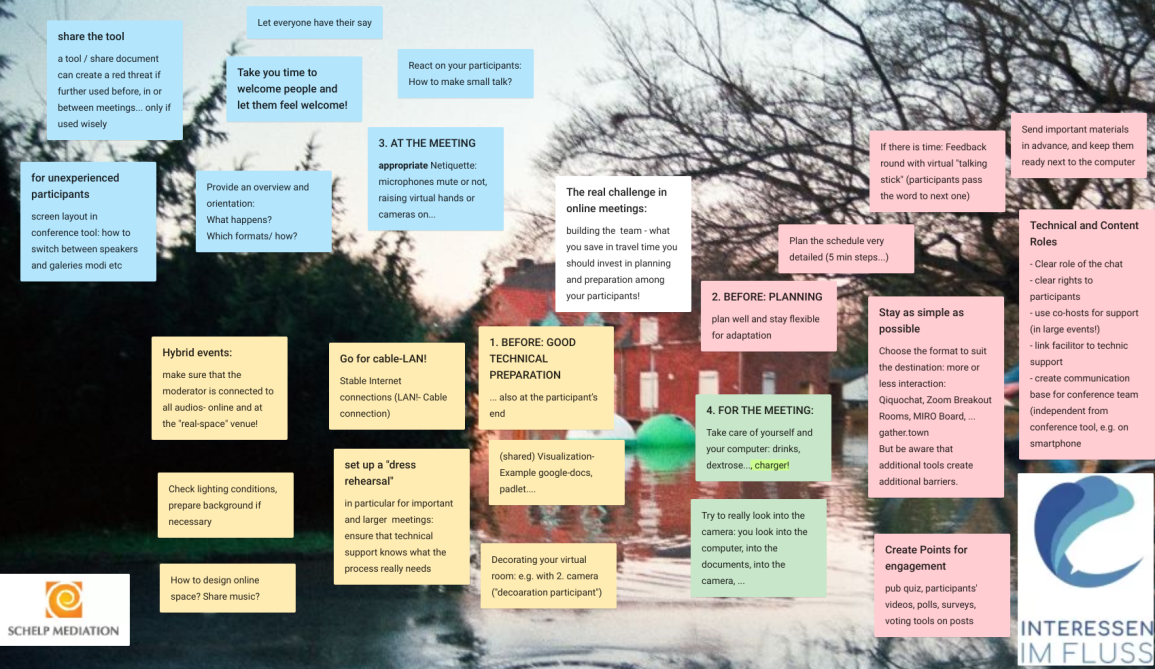Most of us have learned more about how to set up virtual meetings in the past few months than we ever wanted to know. At one of this year’s North Sea Conference virtual chatrooms my colleague Claudia Schelp and I collected the most important lessons learned.
The real challenge in virtual space: Start TEAM BUILDING before the event
Getting people to interact is the real challenge in online meetings. Torben Quickert from Senatsverwaltung in Bremen points out: Not only transnational projects are often set up so that partners can work decentralized. Since virtual meetings do not offer coffee breaks to network and bring partners together, it takes special effort to turn a partnership into a team, and to ensure that virtual meetings and joint events really profit from their transnational nature.
The benefit of virtual meetings: no travel time. Use that time to get everyone involved…
It helps if partners are already strongly involved during the preparation phase of a meeting. The Art Form project launched a video competition for which the participants had to think ahead and prepare before the event. For the TOPSOIL partnership meeting, we set up focused sessions of 1,5 hours e.g. on agricultural impact on groundwater, and invited the partners for a short presentation and the preparation of discussion questions.
… and choose your tools well!
There are plenty of tools that facilitate interaction in online meetings: polls, voting, chats, participants’ videos, break-out rooms, etc. But it’s even more important than in real-space meetings to use them carefully. Yes, switching between two tools like sli.do for surveys, and Zoom for the actual conference can help you to collect questions and conduct surveys. However, not all participants can easily switch between these tools: They might have to work with different browsers, windows… Alternatively, shared visualization can foster joint discussions. And if you simply share your screen, there is no additional stress for your participants!
sli.do, chat function, integrated surveys, padlet, shared google docs… There are pleny of options, depending on the aim of the meeting, and the number and kind of participants. We have much experience implementing online meetings with an appropriate amount of interaction. So if you need assistence, we are happy to help you!
Simple technology where the devil is not just in the details: Conference Tools
Just click and connect – online conferencing seems so easy! However, the software behind it and the interface to the audio/video hardware are not always easy to handle. Their successful use requires very close cooperation between facilitator and technical support. Zoom, gotomeeting, Webex, hopin – no matter which tool you decide on, its great power gives you great responsibility! Use it. The bigger the event, the more important it is to have centralized rights (e.g. muting all participants, restricting screen sharing). Accidentally opened mics provide unwanted glimpses into office discussions and can even disturb the main presenters. And never forget to spread responsibilities: Technical co-hosts for example can help to prepare break-out groups in good time. However, make sure that your co-hosts and facilitators have a way to communicate directly during the meeting e.g. with a smartphone based messenger service.
ZOOM or Skype for Business: you can have both!
Many organizations can do either Zoom or Skype for Business. But you can open your ZOOM conference to Skype for Business Users if a) they have installed a “Skype for Business Connector” and b) if you as host of the meeting have checked the respective box in your ZOOM account profile.
Look in your ZOOM-profile for “Allow Skype for Business (Lync) client to join a Zoom meeting”
in ADMIN> Account Management > Account Settings > In Meetings (Advanced)
…and if you want to include participants with phone connection only: keep your meeting passwort numerical! For most people it is difficult to type letters into their phone…
Netiquette: Adapt rules of conduct to group size
At large virtual events, everyone knows that the event host structures and controls interaction – and participants expect it. However, as Albin Hunia from the NSR Contact Point in The Netherlands points out, any strict “netiquette” must match the size of the group and the goal of the meeting. While the switching on of video feeds and sound must be controlled in large meetings, in small groups all participants can activate their cameras and mics for livelier discussions. Even then, the role of the facilitator is important: They have to take care of any annoying beeping during the discussion, they react to participants’ questions and signs, and give them the floor when they signal their wish to speak either via the “virtual” or their actual hand. Facilitators ‘create’ the room by being relaxed and just talking to the arriving participants.
At the meeting: Be prepared, have fun, stay calm and carry on!
No matter how well prepared you are, something can always go wrong. But if the internet connection goes down, the cameras stop working and microphones go rogue – just relax! Of course, your meeting can be planned to be more resilient: Schedule a decentralized backup host / moderator so that the fate of your event isn’t just in the hands of one person in one building (and with one internet connection). Prepare these co-hosts so that they can bridge disruptions and simplify the ambitious objectives for your event if the need arises.
And even more important, remember: Virtual events can contribute to cooperation and interaction. Carefully planned and implemented, they also are fun because they virtually enable new experiences without the stress of travel. So go for them – and if you need help, drop us a line!

